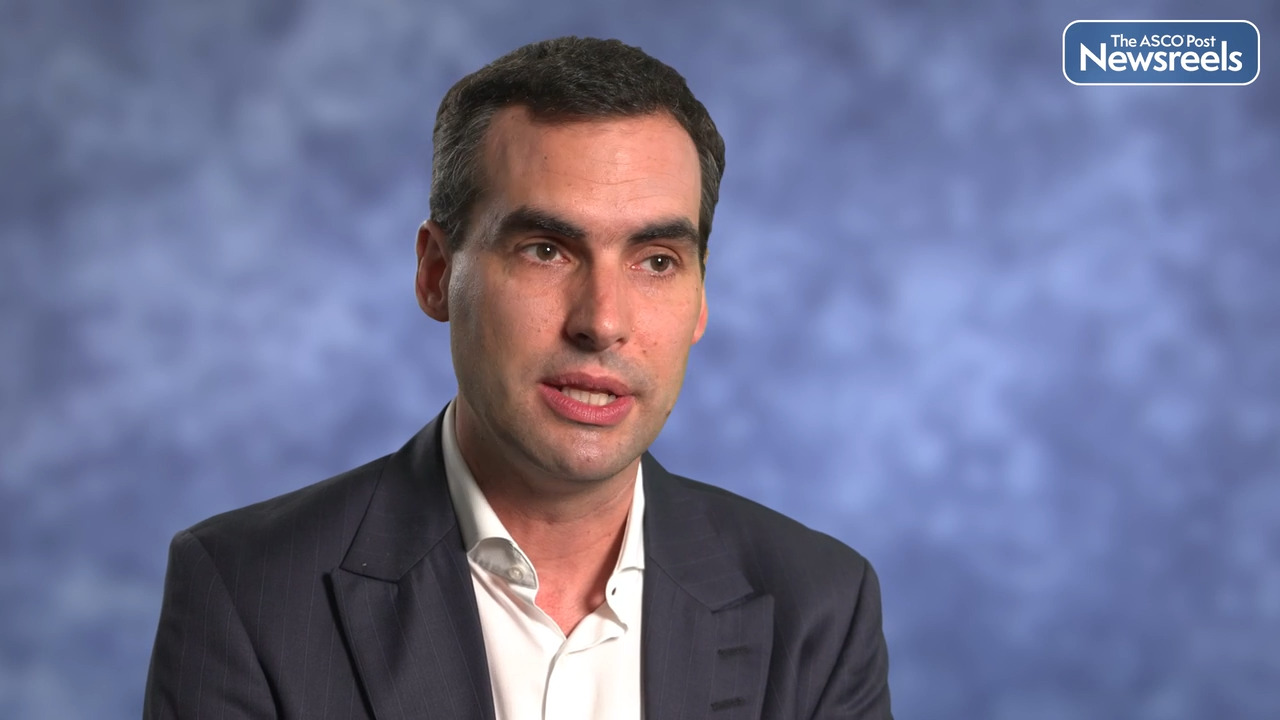Neal D. Shore, MD, on Prostate Cancer: Biomarker Analysis, Enzalutamide, and Active Surveillance
ESMO Congress 2022
Neal D. Shore, MD, of Carolina Urologic Research Center/Genesis Care, discusses new data from the ENACT trial, which showed that patients with prostate cancer and the RNA biomarkers PAM50 and AR-A were likely to have better outcomes with enzalutamide treatment. The results suggest that such RNA biomarkers may help to identify patients who may benefit from enzalutamide treatment compared with active surveillance (Abstract 1385P).
Transcript
Disclaimer: This video transcript has not been proofread or edited and may contain errors.
We published our results from the ENACT trial just a couple of months ago in JAMA Oncology. It was an interesting trial design. It was phase two, a little over 230 patients, one to one randomization; grade group one enriched and grade group two patients. Half the patients we continue to monitor in traditional active surveillance and the other half of the patients received full dose enzalutamide, the oncolytic dose for advanced prostate cancer patients. Our primary endpoints included progression, therapeutic progression based upon moving to active intervention treatments and PSA elevations. And then we also had biopsy key data at one year and two year. The patients received in the treatment arm, open label therapy with enzalutamide for one year. What we saw was a marked decrease in positive biopsy rates and a benefit to staying on treatment, on active surveillance when taking administering enzalutamide. More patients, in other words, who did not take the enzalutamide went on to active treatments.
Now I want to be perfectly clear because of some of the reaction and comments I saw from my colleagues that robust education on active surveillance is really important. But what we know is that many physicians and many patients have a difficult time staying the course of active surveillance. They go to treatment, surgery, radiation, focal therapies for a whole sundry of reasons, including PSA kinetics and concern about not doing something actively when there's cancer present. Our biomarker study looking at PAM50, luminal and basal components, as well as antigen receptor activation, as well as the Decipher score has now clearly demonstrated that we can have a prognostic benefit for patients who had high Decipher scores to know that they would go on to therapeutic progression, which was the endpoint of the ENACT trial and looking at AR amplification as well as the PAM50 luminal basal delineations, we can see, and our first author, Ashley Ross, senior author, Ted Schaeffer have clearly demonstrated that these RNA biomarkers are very informative.
So as we move towards more understanding of who would be a better candidate for active surveillance versus taking a treatment, I think these will be very helpful. I look forward to additional trials where we may dose adjust with the AR blocker. We may find different ways to administer the AR blocker, perhaps intraprostatic injection or perhaps different dosing, different dose scheduling. The bottom line I think, this RNA biomarker analysis is helping us to further inform physicians and patients regarding personalized decision making and fidelity to an active surveillance protocol and avoiding active treatments that may be more morbid and more costly.
The ASCO Post Staff
Neil D. Gross, MD, of The University of Texas MD Anderson Cancer Center, discusses data from a phase II study, which showed that neoadjuvant cemiplimab-rwlc in patients with stage II–IV (M0) resectable cutaneous squamous cell carcinoma is active and may enable function-preserving surgery in some cases (Abstract 789O).
The ASCO Post Staff
Tony S.K. Mok, MD, of The Chinese University of Hong Kong, discusses two late-breaking abstracts presented at ESMO 2022: the phase II SUNRISE study, which compared sintilimab plus anlotinib vs platinum-based chemotherapy as first-line therapy in patients with metastatic non–small cell lung cancer (NSCLC); and the ORIENT-31 trial, which compared sintilimab with or without IBI305 (a bevacizumab biosimilar) plus chemotherapy in patients with EGFR-mutated nonsquamous NSCLC who experienced disease progression on EGFR tyrosine kinase inhibitors.
The ASCO Post Staff
Thomas Powles, MD, PhD, of Barts Health NHS Trust, Queen Mary University of London, and Christopher Sweeney, MBBS, of Dana-Farber Cancer Institute, discuss two important phase III studies on renal cell cancer (RCC) presented at ESMO 2022: IMmotion010, which examined the efficacy and safety of atezolizumab vs placebo as adjuvant therapy in patients with RCC at increased risk of recurrence after nephrectomy; and CheckMate 914, which compared nivolumab monotherapy or nivolumab combined with ipilimumab vs placebo in patients with localized disease who underwent radical or partial nephrectomy and who are at high risk of relapse. (Abstract LBA4 & LBA66).
The ASCO Post Staff
Bernd Kasper, MD, PhD, of Germany’s Mannheim Cancer Center, discusses phase III data from the DeFi trial, the largest study conducted to date for patients with desmoid tumors. The trial showed that the gamma secretase inhibitor nirogacestat demonstrated improvements in all primary and secondary efficacy endpoints. Although considered benign because of their inability to metastasize, desmoid tumors can cause significant morbidity and, occasionally, mortality in patients (Abstract LBA2).
The ASCO Post Staff
Marinde J.G. Bond, PhD Candidate, of the University Medical Center, Utrecht, discusses phase III findings from the CAIRO5 study of the Dutch Colorectal Cancer Group, the first such trial in defined subgroups of patients with initially unresectable colorectal cancer liver metastases and left-sided and RAS/BRAF V600E wild-type tumor. The study compared FOLFOX/FOLFIRI plus either bevacizumab or panitumumab (Abstract LBA21).





